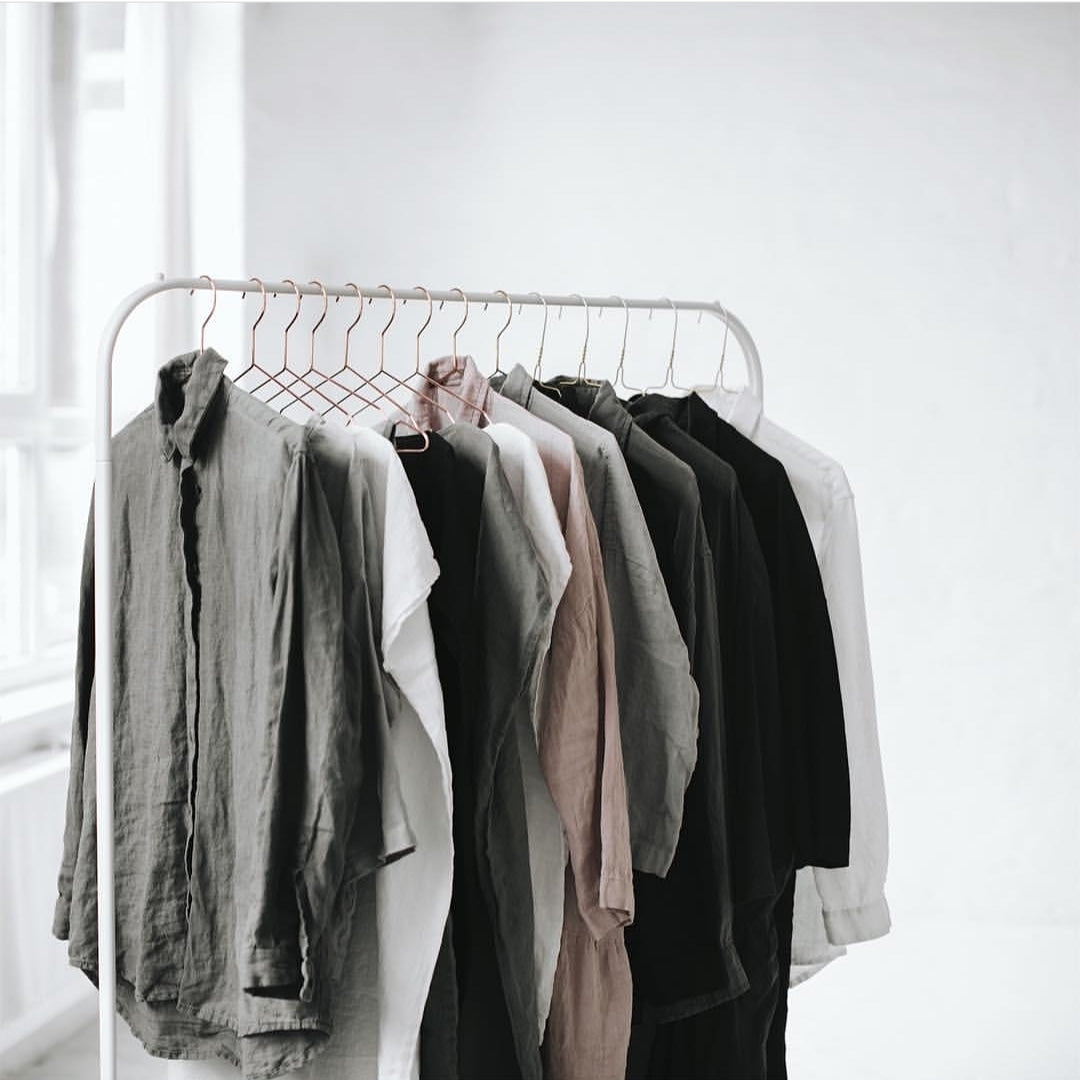For years, we've been told that a high thread count is the ultimate sign of luxury bedding. It’s a simple number that seems to promise incredible softness and quality. But the truth is, a sky-high thread count can often be more of a marketing gimmick than a genuine measure of excellence. Real luxury is found in the quality of the materials and the skill of the craftsmanship, not just a number on the package.
The Great Thread Count Myth
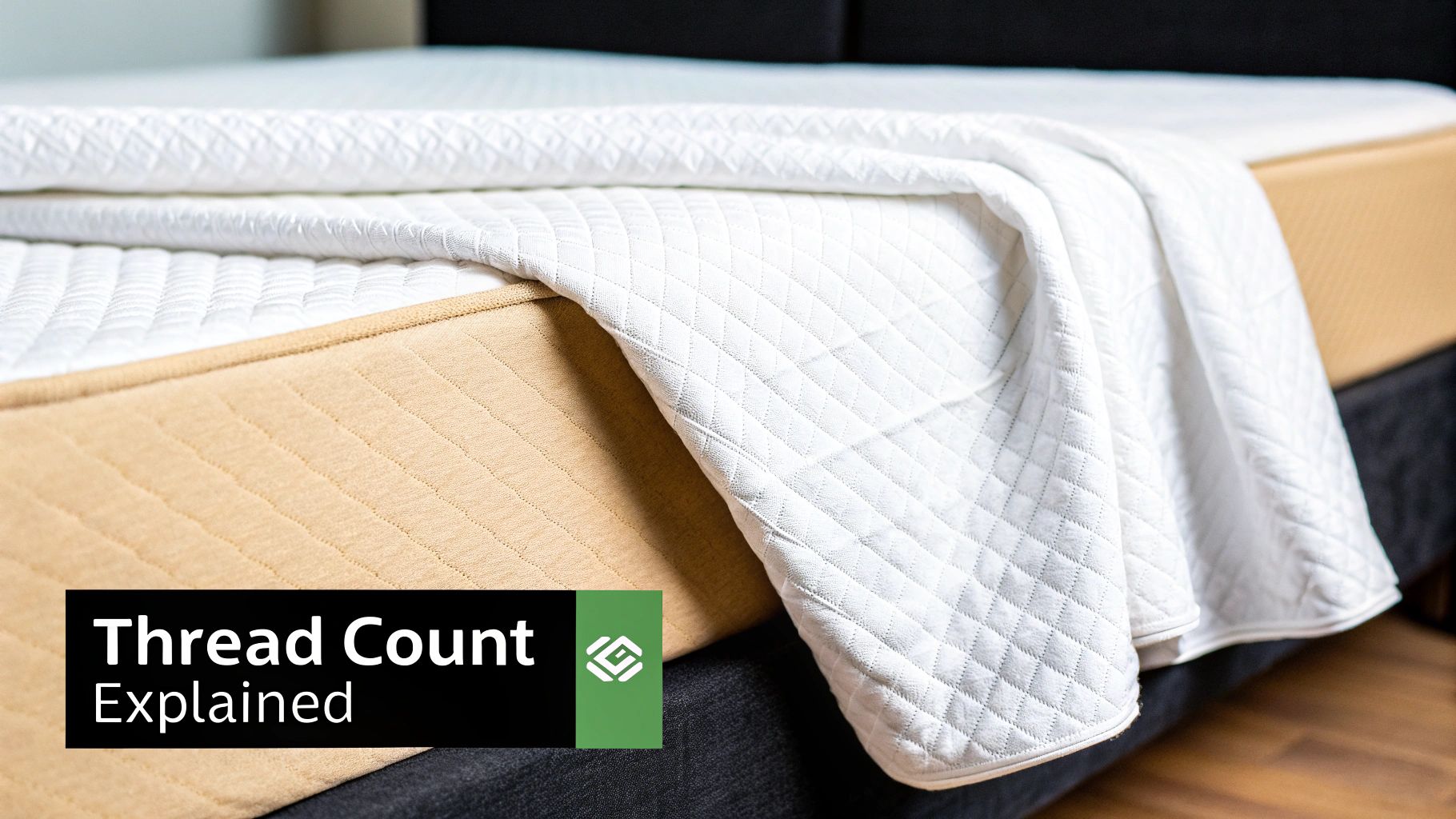
The idea that "more is always better" is easy to fall for, but it’s a seriously misleading assumption when it comes to sheets. An eye-popping thread count often hides lower-quality materials or clever manufacturing shortcuts designed to inflate the number. This narrow focus distracts from what really makes for beautiful, long-lasting bed linen.
Here’s a good analogy: it’s like buying a digital camera. A camera boasting a massive megapixel count sounds amazing, right? But if the lens is cheap and cloudy, your photos will still turn out blurry and disappointing. The lens is the most critical part because it’s what actually captures the light and detail.
In the world of bedding, the cotton fibre is the lens.
High-quality, long-staple cotton is the absolute foundation of superior sheets. It creates yarns that are inherently smoother, stronger, and more lustrous. Without premium cotton, even the highest thread count will fail to deliver genuine comfort and durability.
This is where the marketing for high thread count sheets can get a bit deceptive. Some manufacturers use weaker, short-staple cotton and twist several thin, low-grade threads together to form a single, thicker "multi-ply" yarn. This trick allows them to artificially boost the final count.
For example, a sheet woven with 333 threads per square inch using three-ply yarns can be legally marketed as a 1000 TC sheet. This practice is so widespread that when one New Zealand company started out in 2010, industry insiders actually laughed at the idea of a genuine 1000 TC sheet, calling it an industry joke. You can learn more about how these numbers are calculated from local linen specialists.
What this means for you is that a 1000 TC sheet made with cheap, multi-ply yarn can feel rougher and wear out much faster than a 400 TC sheet woven from superior single-ply, long-staple cotton.
Key Factors Beyond the Count
So, instead of getting caught up in inflated numbers, it’s far better to focus on the real markers of quality.
Here’s what you should actually be looking for:
- Fibre Quality: Is it long-staple cotton like Supima® or Egyptian? This is the single most important factor for softness and strength.
- Yarn Type: Are the sheets made with single-ply yarn? This is a sign of a stronger, more honest construction without any tricks.
- Weave Type: Do you prefer the crisp, cool feel of a percale weave, or the silky smoothness of sateen? The weave completely changes how the sheets feel to sleep on.
Once you understand these elements, you can see right past the marketing hype. If you're ready to find the perfect balance for your own bed, you might be interested in our guide on finding the best thread count for sheets.
Understanding What Thread Count Really Means
At its heart, thread count is a simple measurement. It's the total number of threads woven together in a specific area of fabric—in New Zealand, we usually measure this over a 10cm² patch. The number you see on the packaging is just the vertical threads (the warp) added to the horizontal threads (the weft).
Think of it like this: if you have 150 threads running up and down and another 150 running side to side within that small square, you’ve got a 300 thread count. Simple enough, right? But here’s where things get complicated, because that number says nothing about the quality of the threads themselves.
The real story isn't in the count, but in the yarn's ply. This is the secret that separates genuine luxury from a marketing gimmick.
The Secret of Ply: Single vs Multi-Ply Yarns
Ply tells you how many strands of fibre are twisted together to create a single thread. It’s a crucial detail that often gets glossed over.
-
Single-Ply Yarns: This is what you want. Each thread is made from a single, long, and strong fibre. Because it’s made from one continuous strand, the resulting fabric is incredibly smooth, durable, and resistant to pilling. It’s a sign of quality craftsmanship.
-
Multi-Ply Yarns: This is where thread counts get inflated. Manufacturers twist together several shorter, weaker fibres to create one thread. This is a common practice with lower-grade cotton. While it makes the yarn thicker, it also makes it coarser and much more likely to break down over time.
So, how do brands claim those sky-high numbers like 1000 thread count? They're not using 1000 premium threads. Instead, they might use 250 four-ply threads and count each of the four tiny strands within every single thread. Just like that, the number is quadrupled, and the package looks impressive, but the quality simply isn't there.
A 400 thread count sheet made from superior single-ply, long-staple cotton will almost always feel softer and last longer than a 1000 thread count sheet made from inferior multi-ply yarns. The quality of the fibre and the honesty of the ply are far more important than the final number.
This infographic shows the connection between a higher thread count and the resulting characteristics of the sheets.
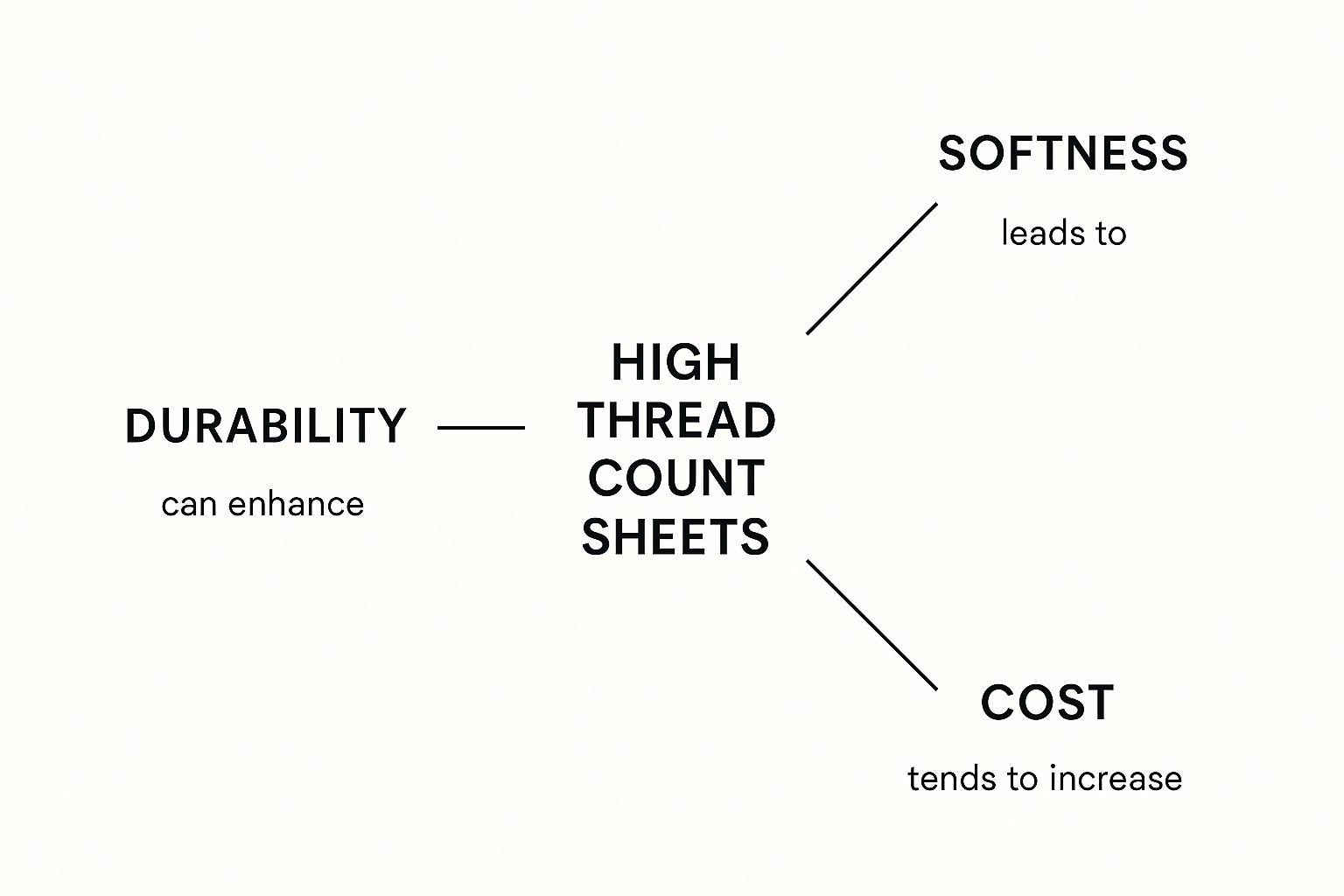
As you can see, cramming more threads in can certainly make sheets feel softer, but it also increases the cost and can trap heat, making them less breathable. It's all about finding the right balance.
What This Means for You as a Shopper
Now that you know the difference between warp, weft, and ply, you're equipped to see past the marketing noise. When you come across a set of "1200 thread count sheets" with a surprisingly low price tag, you can be pretty sure you’re looking at a product made with cheap, multi-ply yarns.
A truly high-quality sheet with a high thread count is an investment for a reason. It's woven from an enormous amount of premium, single-ply cotton, which is expensive to source and intricate to weave. This is what gives you that genuine, lasting comfort.
So next time you're shopping for new bedding, don't be swayed by the thread count alone. Look a little deeper. Asking about the ply is one of the smartest moves you can make to ensure you're bringing home true luxury that's built to last.
Why Cotton Quality Always Wins
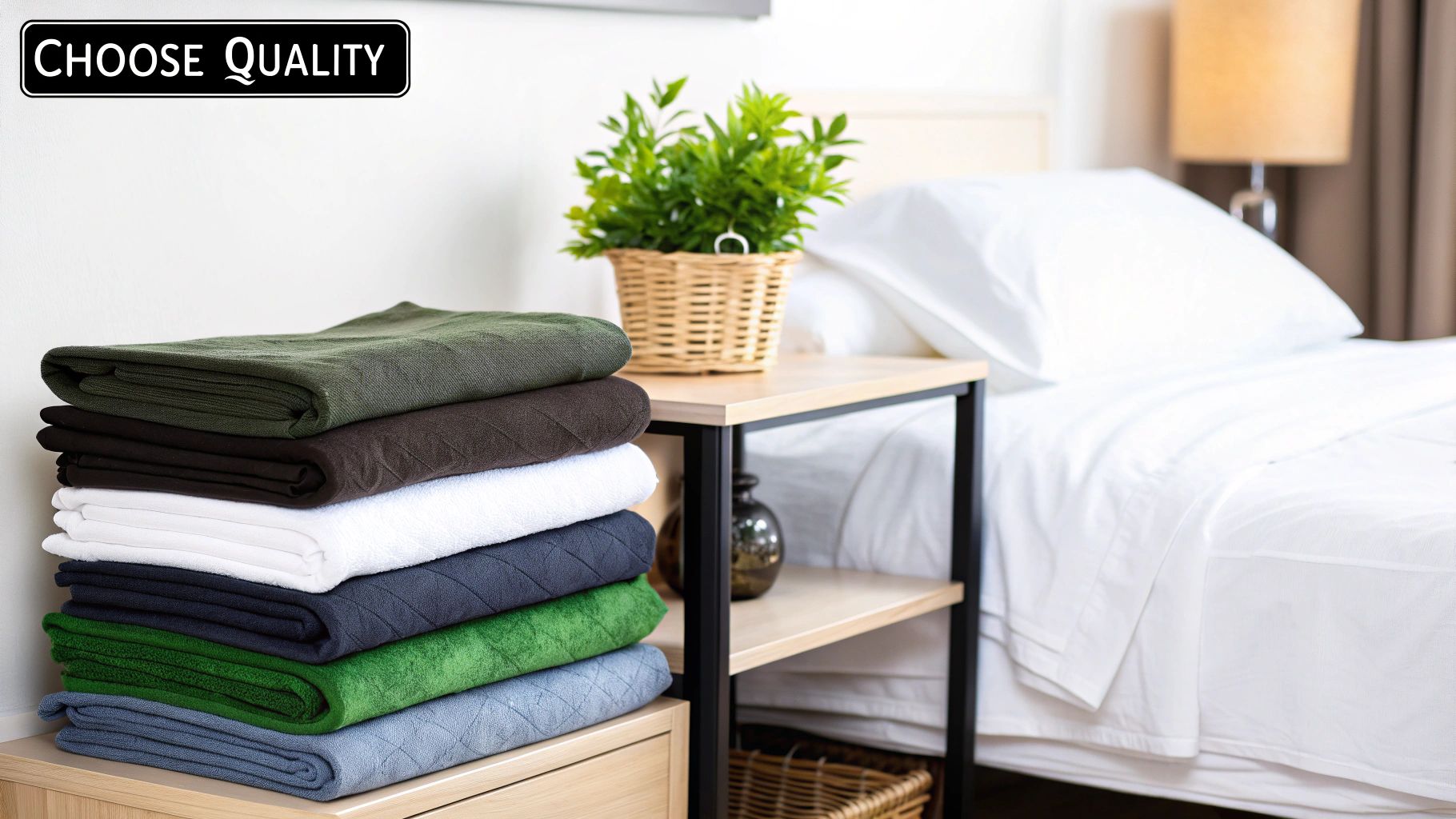
While thread count often steals the spotlight, the real secret to truly luxurious sheets lies in a far more fundamental element: the quality of the cotton itself. Obsessing over a high thread count is a bit like judging a gourmet meal by the number of ingredients rather than their freshness and quality. The simple truth is, no amount of threads can compensate for poor-quality cotton.
Think of it like building a brick wall. You could use thousands of small, crumbly, low-grade bricks. The number might sound impressive, but the wall would be weak, rough to the touch, and likely to fall apart. Or, you could use fewer, high-quality bricks—strong, smooth, and perfectly formed. That wall would be superior in every single way.
Cotton works in exactly the same way. The most crucial factor determining the final quality of your sheets is the length of the individual cotton fibre, known as its staple.
The Power of Long-Staple Cotton
Cotton fibres are categorised by their length. Long-staple and extra-long-staple cottons, like genuine Egyptian or Supima®, have remarkably long, fine fibres. These superior fibres can be spun into yarns that are simply better on every level.
- Exceptional Smoothness: Longer fibres mean fewer tiny ends poking out from the yarn. This creates a fabric that feels noticeably smoother and softer against your skin.
- Inherent Strength: The continuous length of these fibres creates a stronger, more resilient yarn. This means sheets made from long-staple cotton are far more durable and can stand up to years of use and washing.
- Pilling Resistance: Pilling happens when short, weak fibres break and tangle on the fabric's surface. Because long-staple cotton has far fewer of these weak points, it naturally resists forming those frustrating little balls of fuzz.
In contrast, short-staple cotton is made up of fibres that are coarse and short. When spun, they create a yarn riddled with weak points and exposed ends, leading to a rougher feel and a product that wears out much faster. This is the very cotton often used to artificially inflate the thread count in lower-quality sheets.
Cotton Quality vs Thread Count At A Glance
To really see how these factors play out, let's compare some common scenarios you might find when shopping for bed linen here in New Zealand. This table breaks down how different combinations of cotton and thread count actually perform in the real world.
| Sheet Type | Feel & Comfort | Durability | Breathability | Verdict |
|---|---|---|---|---|
| Low TC, Short-Staple Cotton | Rough, scratchy, and uncomfortable from day one. | Poor. Prone to tearing and pilling very quickly. | Often surprisingly breathable due to the loose weave. | Avoid. A poor sleep experience with no long-term value. |
| High TC, Short-Staple Cotton | Initially feels thick but lacks genuine softness. Often coarse. | Poor to moderate. The multi-ply yarns can break down easily. | Low. The dense weave and thick yarns trap heat. | The classic marketing trap. A high number but low quality. |
| Moderate TC, Long-Staple Cotton | Beautifully soft, smooth, and gets even better with each wash. | Excellent. Strong single-ply yarns ensure lasting quality. | Excellent. The balanced weave allows for optimal airflow. | The sweet spot. Delivers true luxury, comfort, and value. |
| High TC, Long-Staple Cotton | Incredibly soft, silky, and drapes beautifully on the bed. | Excellent. Woven from the best materials for ultimate longevity. | Good, but can be less breathable than moderate TC options. | A true luxury item. Ideal if you love a dense, silky feel. |
As the table shows, a moderate thread count (around 300-600) made from high-quality, single-ply, long-staple cotton consistently wins out. It delivers the perfect balance of softness, strength, and breathability, beating sheets with an inflated thread count made from inferior materials every time.
The ultimate takeaway is this: Always prioritise the quality of the fibre over the quantity of the threads. Investing in sheets made from premium long-staple cotton is the single best decision you can make for lasting comfort and a truly luxurious sleep.
While cotton is a fantastic choice, it's not the only one. For those who love a more relaxed, textural feel, it's worth exploring other natural fibres. You can discover more by reading about the benefits of pure natural linen and seeing how its unique properties stack up. After all, the material itself is the true foundation of your comfort.
Why Do Luxury Sheet Prices Vary So Much in NZ?
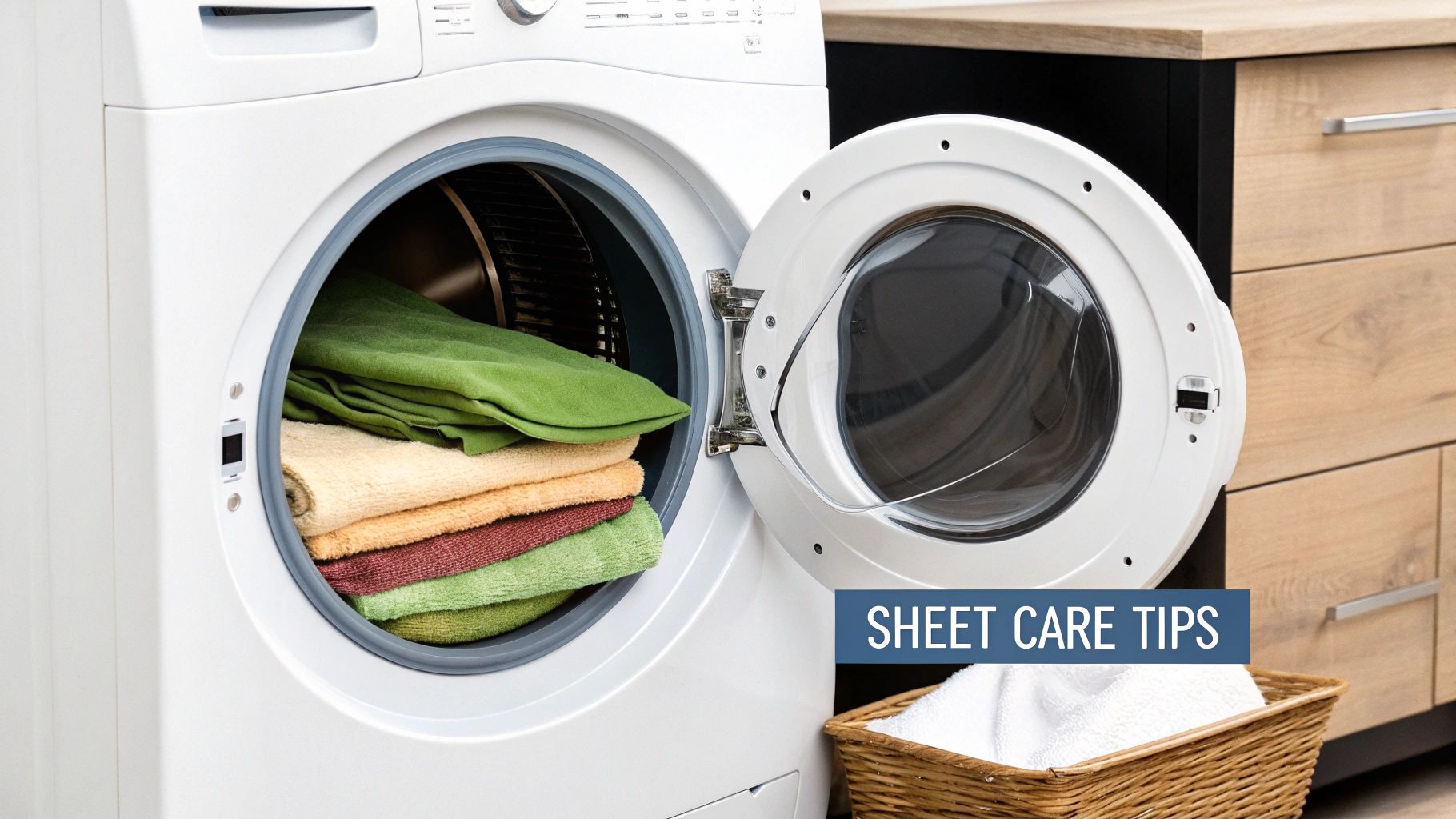
If you've ever shopped for bedding in New Zealand, you've probably scratched your head at the massive price gap. How can one set of 1000 thread count sheets cost a small fortune, while another with the same number seems like a bargain? It all comes down to the quality of the cotton, how the yarn is made, and what’s really going on behind that number on the label.
A genuine high thread count sheet is a labour of love. It takes an incredible amount of premium, fine thread to weave something so dense and luxurious. When you’re using top-tier, long-staple cotton, the cost of the raw material alone sends the price tag soaring.
Simply put, a higher price is often a good sign you’re getting high-quality ingredients. That deal that looks too good to be true? It probably is.
The True Cost of a High Thread Count
So, how do some manufacturers slap a big number on the package without the high price? They take a shortcut, and it’s a big one: they use cheaper cotton. By spinning short, brittle cotton fibres into multi-ply yarns, they can artificially inflate the thread count.
Technically, they get the number they want, but the final product is a world away from true luxury. It lacks the softness, durability, and breathability you’re paying for. This is the single biggest reason for the huge price differences you see on the shelf. You aren't just paying for a number; you're paying for the quality of the fibre behind it.
A genuine luxury sheet costs what it does because it’s an investment in superior materials and careful craftsmanship. The budget version, on the other hand, cuts corners where it counts, leaving you with sheets that feel coarse, sleep hot, and fall apart after a few washes.
A Guide to NZ Market Prices
Knowing what to expect price-wise can save you from clever marketing tricks. Here in New Zealand, what you pay for high thread count sheets is a direct reflection of the cotton inside.
- A 1000 TC sheet set made from genuinely high-quality cotton will typically set you back between NZD $600 and NZD $900.
- For the absolute best of the best, like sheets made from DNA-tested Egyptian cotton, you can expect prices to climb to between NZD $1,200 and NZD $2,000.
Those figures aren't just plucked from thin air; they reflect the immense amount of premium cotton required to create such a dense, beautiful weave.
The price is often the most honest indicator of quality. If you spot a 1000 TC sheet set for a bargain-basement price, you can be almost certain it’s made from lower-grade cotton and multi-ply yarns to create an illusion of luxury.
Ultimately, choosing bed linen is about so much more than a number. It's about investing in your comfort and getting something that lasts. Once you understand the link between fibre quality and price, you can see why luxury bed linen is worth the investment and choose sheets that will feel incredible for years to come.
Finding the Sweet Spot for Your Sheets
Alright, we’ve busted the myths around those crazy-high thread counts. So, what should you actually look for? The real goal isn't to chase the biggest number on the packet, but to find that perfect balance point where softness, durability, and breathability all come together. This is the secret to genuinely luxurious sleep, night after night.
Ask any textile expert, and they'll tell you the magic happens in a surprisingly specific range. For high-quality, single-ply, long-staple cotton sheets, that sweet spot is generally between a 300 and 600 thread count. This isn't some arbitrary number; it’s considered the sweet spot for very good reasons.
Sheets in this bracket have enough threads to feel wonderfully soft and smooth against your skin, but not so many that they suffocate the fabric. This is a game-changer for comfortable sleep, especially with New Zealand's changing seasons. It allows air to move freely, preventing you from overheating and waking up in a sweat.
How Weave Changes Everything
But thread count is only half the picture. The weave is what gives a sheet its distinct personality. The two main players here are percale and sateen, and they feel completely different, even within that same 300-600 TC range. Getting your head around this is your key to choosing sheets you’ll truly love.
-
Percale Weave: Think crisp, cool, and matte. Percale uses a simple one-over, one-under grid pattern. At the lower end of our sweet spot (300-400 TC), it feels light and airy, like that amazing sheet from a high-end hotel. Push it towards 500 TC, and it gets smoother and more substantial, but still keeps its signature crispness.
-
Sateen Weave: Famous for its silky feel and subtle sheen, sateen uses a different pattern—one thread under, three or four over. This structure creates a fabric that drapes beautifully and feels exceptionally smooth. A 300-400 TC sateen has a fluid, buttery softness, while a 500-600 TC version becomes even richer and more luxurious, with a comforting, heavier feel.
The perfect combination of thread count and weave comes down to what you prefer. A 400 TC percale gives you that classic, hotel-crisp experience—ideal if you tend to sleep warm. On the other hand, a 500 TC sateen delivers a silkier, more decadent feel for those who want to be cocooned in softness.
Your Practical Shopping Guide
So, what does all this mean when you’re actually shopping for new sheets? First, forget the obsession with any number over 800. Instead, narrow your search to sheets that sit comfortably within that 300 to 600 thread count range.
Once you've got the thread count sorted, your next decision is about the feel. Ask yourself what you want from your bed. Do you run hot and crave a crisp, cool touch? Percale is your go-to. Or do you prefer a warmer, silk-like drape that envelops you? Then sateen is the obvious choice.
By putting this knowledge together, you can sidestep the marketing hype and confidently pick sheets that deliver on all fronts: the luxury feel you want, the durability you need from an investment, and the breathability that’s essential for a great night’s sleep. This is how you find your perfect match.
How to Choose and Care for Your Bed Linen
Right, so now that you know what actually makes for great sheets, you can shop with a bit more confidence. It’s all about looking past the flashy marketing claims on the packaging and focusing on what truly matters. This guide will walk you through picking out beautiful bed linen and, just as crucially, how to look after it so it lasts for years to come.
Choosing the right sheets is a bit like being a detective. Instead of letting a huge number on the box sway you, it’s time to train your eye to spot the real signs of quality. The label is your best friend here—it holds all the clues you need.
What to Look For When Buying
Your shopping checklist should put the fundamentals first. Remember, a high thread count means very little if the cotton itself is poor quality.
Here’s a simple checklist to keep in mind:
- Fibre Content: First things first, check what the sheets are actually made of. You want to see 100% long-staple cotton like Supima® or genuine Egyptian cotton on the label. Be wary of vague terms like “cotton blend” or “cotton rich”—they’re often red flags.
- Weave Type: Think about the feel you prefer. Are you someone who loves the light, crispness of percale, or do you prefer the silky, smooth drape of sateen? The weave makes a massive difference to how the sheets feel against your skin.
- Ply Construction: If the packaging mentions it, look for single-ply yarns. This is a hallmark of a stronger, more honest fabric. If you see a super-high thread count but no mention of ply, it’s a safe bet it’s multi-ply.
- Feel the Fabric: Whenever possible, actually touch the sheets. High-quality cotton has a noticeable softness and smoothness that you just don't get with cheap, short-staple cotton.
It pays to be sceptical of ridiculously high numbers. As consumer testing right here in New Zealand has shown, a higher thread count doesn't always equal better quality. In one study, a set of 1000 TC sheets started pilling after just 1000 test rubs, while a more modest 400 TC set held up for 7000 rubs before showing any wear. You can read more about these findings from local consumer reports.
The takeaway is clear: the quality of the fibre and the integrity of the weave are far more reliable indicators of durability than a simple thread count number.
Protecting Your Investment with Proper Care
Once you’ve brought your beautiful new linen home, looking after it properly is key to preserving its feel and lifespan. Following a few simple rules will help you avoid common problems like pilling, shrinking, and premature wear, ensuring you get the most out of your purchase.
Washing Your Linen Getting the wash right is the first step to making your sheets last.
- Use a Gentle Cycle: Always wash your sheets on a gentle or delicate cycle. Stick to cold or warm water, never hot, as high heat can weaken and damage the fine cotton fibres.
- Choose a Mild Detergent: Go for a gentle, pH-neutral liquid detergent. Harsh powders and detergents with brightening agents can be abrasive and cause the colour to fade over time.
- Wash Separately: It’s best to wash your sheets on their own or with other similar soft items. Things with zips, buttons, or rough textures can easily snag and damage the delicate weave.
Drying and Storing Your Sheets How you dry your sheets is just as important as how you wash them.
- Line Dry When Possible: Honestly, the best method is to hang your sheets on the line, preferably out of direct sunlight. It’s the gentlest approach and leaves them smelling wonderfully fresh.
- Use Low Heat in the Dryer: If you have to use a machine, tumble dry on a low heat setting. A great tip is to pull them out while they're still slightly damp to stop them from over-drying, which can make the fibres brittle.
- Store Correctly: Keep your linen in a cool, dry, and well-ventilated cupboard. Try to avoid storing them in plastic containers, as this can trap moisture and lead to mildew.
Your Questions About Bed Sheets Answered
Trying to choose new bed linen can feel a bit overwhelming, with so many terms and numbers flying around. To help you shop with confidence, we’ve tackled some of the most common questions we get from our customers across New Zealand, breaking down what really matters for a great night's sleep.
Are 1000 Thread Count Sheets Too Hot?
In most cases, yes, they can be. When you see a thread count that high, it usually means the fabric has been woven incredibly densely. This tight construction doesn't leave much room for air to circulate, which can trap body heat and make for a stuffy, overly warm sleep – not ideal for New Zealand’s varied climate.
The real culprits are often sheets that use chunky, multi-ply yarns just to inflate the thread count number. A far better choice for comfortable, breathable sleeping is a sheet in the 300–500 thread count range, crafted from high-quality, single-ply, long-staple cotton. For an even cooler feel, look for a crisp percale weave.
What Is the Difference Between Percale and Sateen?
It all comes down to the way the threads are woven together. This difference in weave creates two completely distinct textures, so knowing which you prefer is key to finding your perfect set of sheets.
-
Percale Weave: Think of a simple, one-thread-over, one-thread-under grid. This classic pattern creates a fabric that’s light, crisp, and exceptionally breathable, with a clean, matte finish. If you love that fresh, cool-to-the-touch hotel sheet feel or tend to sleep hot, percale is for you.
-
Sateen Weave: This weave is a little more complex, typically with one thread under and three or four threads over. By exposing more of the thread's surface, this technique produces a silkier, smoother fabric with an elegant, subtle sheen. Sateen drapes beautifully and resists wrinkles better, but it can feel a touch warmer than percale.
How Can I Spot Genuine Egyptian Cotton?
Authentic Egyptian cotton is a truly premium material, and its price will always reflect that. If you spot a set of "Egyptian cotton" sheets with a price that seems too good to be true, it almost certainly is. It pays to be a bit sceptical.
A key thing to look for is official certification. Check the packaging for the Cotton Egypt Association trademark. The label should be very specific, stating it's "100% Long-Staple Egyptian Cotton." Be wary of vague terms like "Egyptian cotton feel" or "cotton blend," as these are tell-tale signs of a lower-quality product.
Ultimately, once you feel it, you'll know. Genuine Egyptian cotton has a softness, smoothness, and durability that's simply in a different league from its imitations.
At The Foxes Den, we believe true luxury is found in the quality of the materials and the honesty of the craftsmanship. We invite you to explore our curated collection of Supima® cotton and pure linen bedding to feel the difference for yourself.
